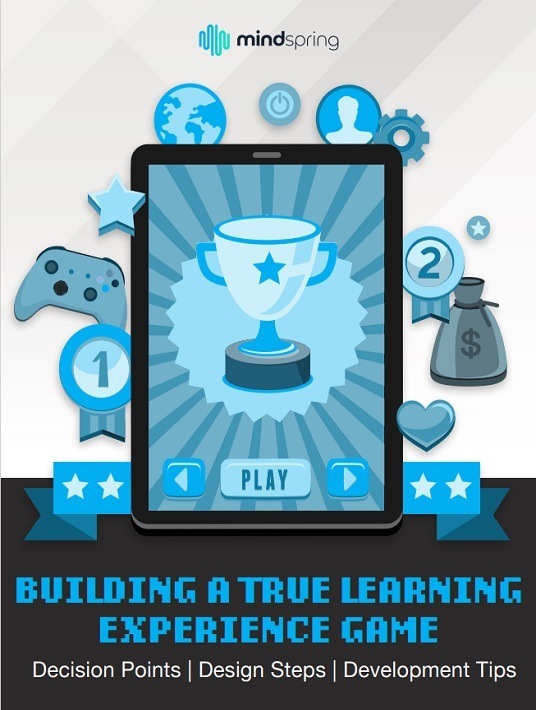Types Of Games That Are Ideally Suited For Online Training
This article is part of a series on building a true training game to increase managers’ understanding of corporate finance. What you are about to read is a fable. The company, AshCom, is fictional, but the learning challenges faced by Kathryn, AshCom’s CLO, and her team are real and commonly shared by learning teams in large organizations. It is our hope that you will be able to connect with the characters, their challenges, and the solutions they discover. We also invite you to read the first eBook in the series.

Games Are Teachers
Kathryn, the Chief Learning Officer at AshCom, had entered the word “games” in her search bar and pressed enter. She quickly scrolled through the results when a quote by Raph Koster, an American game designer, caught her attention: “That’s what games are, in the end, teachers. Fun is just another word for learning.” She reflected on these two simple sentences that would be put into practice by the learning team for their next big project.
Kathryn had been challenged by Kurtis, its Chief Financial Officer, to create a learning experience that would greatly increase the financial literacy of the management team. Kurtis knew that thousands of decisions were being made weekly at the 7,000-person company that would impact AshCom’s performance. What he didn’t know was how these decisions were being made or if the people making them actually understood the basics of corporate finance. Kurtis did not claim to have a solution, but he told Kathryn he suspected it could be some kind of competition.
Kathryn had done some thinking and a little reading. She set a meeting with Adeena, one of her learning team members. Kathryn knew that Adeena was bright, structured, and an excellent instructional designer. She also knew that Adeena had some background in game design. What she didn’t know was Adeena’s passion for games, having played various games since she was little.
Kathryn asked Adeena to prepare a presentation for the learning team. Adeena jumped right in and, a week earlier, walked the learning team members through the basics of gamification, motivation, and a little bit of history. At the end of that presentation, Adeena made it clear that the most likely solution would involve more than adding gamification elements to a course.
Building A True Game
She proposed that the team consider building a true game, something the learning team at AshCom had never done before. Kathryn loved the idea because she was confident if they could learn to build a successful financial literacy game, her team could apply these skills to other learning experiences⎯a new tool in their collective toolbox.
As a follow-up to the first meeting, Kathryn asked Adeena to lead them in a discussion about building a true game, something she was more than happy to do.
Adeena’s initial presentation had struck a chord with her teammates. Several members approached her after the first discussion and told her, “Let me know if you need any help.” There seemed to be a lot of enthusiasm around games.
Kathryn started the meeting by reminding everyone of Kurtis’ request and gave a short summary of their last meetings from the notes she had taken. She said, “At the bottom of my notepad, I wrote “TRUE GAME” in capital letters and circled it.”
Everyone knew that this meant a high priority.
“With that,” said Kathryn, “I want to turn this over to Adeena. We have a lot to cover today.”
“We certainly do,” said Adeena. “I am going to follow Kathryn’s example and use the whiteboard.” As she wrote, she said, “I want to cover two big topics today: Game Structures and Game Motivators.” Each was written at the top of the whiteboard.
Game Structures
“Let’s talk first about Game Structures. There are thousands of games⎯some are played in person, some played on boards of one kind or another. Many are video games. But they generally fit into a handful of categories or genres. I’ll list some of the categories, and I’d like you to think about which games might fit that category as I describe it,” said Adeena. “Ready?” Everyone nodded their heads.
“The first is my personal favorite: Strategy Games. I grew up playing these with my parents⎯games like checkers and chess. But Strategy Games come in all sorts of modalities. One of my favorites is Settlers of Catan. The main point,” she said approaching the whiteboard, “is that the player moves forward by planning and thinking. There isn’t much chance or luck in Strategy Games. You win or lose based on the decisions you make. The connection to learning is that this is what you want when the object is to enhance a player’s strategic thinking skills.”
Adeena continued, “The second is what many people think of when they think about video games: Action. This is pretty simple. For instance, players are confronted with enemies and have to react quickly to defeat them.” She added “Action” under “Strategic” on the whiteboard.
Michael started laughing. “I remember when Doom came out in the 1990s. Some of my fellow professors and I ended up playing until three in the morning. My wife reminds me of that occasionally. I completely lost track of time.”
“That isn’t uncommon at all in action games,” said Adeena. “Dopamine gets delivered quickly in action games and most players want more immediately.”
“The third type of game is Adventure,” said Adeena, again writing on the whiteboard. Players are given a puzzle to solve or some sort of quest. Many times, they are assigned a character who has a backstory. They win by solving the puzzle or completing the mission. If you’ve ever played The Legend of Zelda, then you’ve played a game built as an adventure.”
“The fourth type is Role Playing,” continued Adeena. “Most often, players are the leading characters and face various decision points in their role. The game keeps players’ attention by improving on their performance throughout the game based on their choices. Some of you might have played Assassin’s Creed Odyssey. That’s one example.”
“Which one are we going to build that will make everyone love corporate finance?” said Alishia. This cracked up everyone in the room.
“I’m not sure that’s our ultimate objective,” said Kathryn laughing, “but I can see where we have some choices here. Adeena, are these ever blended?”
“Of course,” said Adeena. “I don’t mean this list to be exhaustive. There are some types I didn’t include. I also don’t mean for these categories to be exclusive of one another. Sometimes, really good games combine several types of games. As to Alishia’s question, I’m not sure we know enough to answer that yet.”
Game Motivators
Then Adeena moved on, “We also need to talk a little about motivation. We know Kurtis not only wants our managers to have a deeper understanding of AshCom’s financial system. He also wants the managers to make choices based on that knowledge. So, we need to think about a learning experience that will not only give knowledge, but it will also have the objective of raising their skills. And to do that, they need to embrace AshCom’s finance system.”
“So, the Know/Do/Believe system?’ said Amy. “I have to tell you that I’ve used that a lot with my other corporate clients, and it sure clarifies things.”
“Exactly,” said Adeena. “There are a number of possible motivations for playing a game. Actually, a better way to say that is that there are various kinds of motivations built into the game itself.”
Kathryn said, “That was a complicated sentence. I’m not sure I’m following you.”
“Then let me try again,” said Adeena. “We need to think about what will motivate managers to understand AshCom’s corporate finance structure and then act on it. That will help us think about what kind of true game to build. Let’s dive more deeply, and maybe it will become clearer.”
“Game motivation comes in many forms, but, like game structures, there are a few big categories we should consider. One of the most obvious is Avoidance. Think about the average Action game. You might be motivated by eliminating your enemies, but you are also highly motivated by not being eliminated.” Kathryn nodded.
“Another motivation can be Scarcity. Part of this is human nature. If diamonds were common, how much would they cost? The same thing happens in a game. If a reward is rare, players will be highly motivated to achieve it. Of course, this can be overdone. If they are too rare or too difficult to get, players will give up.”
“Does some of this depend on the person playing the game?” asked Maggie.
The Factors
“Yes,” said Adeena. “As with the different kinds of game structures, it is a good idea to offer several different motivators in a game, knowing that what motivates one player might not motivate another at the same level. For instance, another possible motivator is Ownership. Some games motivate people by giving them a sense of ownership. This is related to both Scarcity and Avoidance. If something is scarce and you have the opportunity to possess it by playing well, you will also be motivated to protect it. You want to avoid losing it to the game or to another person.”
“Makes sense,” said Maggie. “This really does get into psychology.”
“Absolutely. Actually, I would call it learning science,” said Adeena. “Now that you’ve got the hang of this, let’s cover a few more. Players can be motivated by games that give them an opportunity to be involved in something bigger than themselves. These are called Epic Games and play well with people who want to change the world.”
“Has anyone ever played Candy Crush?” asked Adeena. Everyone but Michael raised their hands. “That game uses the motivation of Accomplishment. On the surface, Michael might look at someone else playing and wonder why anyone would play a game like that. But if he played it, he would find that it gives players a feeling a pride and accomplishment. The game gets harder as you go, so it keeps feeding the need to accomplish the next level.”
“Pavlov was right?” asked Michael laughing.
“Yes, to some degree and for some players,” said Adeena. “There are other motivators we should consider like Social Influence and Empowerment. Some games heavily use the fact that we tend to care deeply about what others think of us or our desire to be part of a team. Others are highly motivated by games that give them a greater sense of power or control.”
“I know we only have a few minutes left, so I want to make this last part interactive. We have four types of games on the whiteboard: Strategy, Action, Adventure, and Role-Playing.”
Adeena continued, “We also have seven possible motivators: Avoidance, Scarcity, Ownership, Epic, Accomplishment, Social Influence, and Empowerment.”
“I’m going to hand each of you two yellow sticky notes. You have to place them next to the type of game you think we should build for financial literacy.”
“You are also getting three red sticky notes. Please place those next to what you think will be the key motivators for our managers in their financial literacy learning game.”
“Can we discuss the merits of each first?” asked Darryl.
“No,” said Adeena. “If we get mixed results, perhaps we can talk through them. For now, let’s just see where we are at this moment.”
Types Of Games: Taking A Vote
As Adeena suspected, the choices for the game type were unanimous. Strategy had nine, which meant someone put both of their sticky notes there. Role-Playing had the remaining seven.
The choices for motivation were slightly more mixed. Ownership received the most with seven votes. Close behind were Accomplishment and Social Influence, with six votes each.
Kathryn, knowing the meeting needed to end soon, said, “So, we are going to build a true game for hundreds of managers at AshCom with the goal of teaching them how corporate finance works. The game will combine strategy and role-playing using the key motivators of ownership, accomplishment, and social influence.”
“That sums it up,” says Adeena. “We still have many decisions to make, including elements specific to making a game. We also have to talk about price and timeline because both will be beyond what we are used to. But I can tell you that narrowing down the type of game we want and what we will use as motivators is a huge step forward.”
Kathryn closed the meeting by thanking everyone for engaging and Adeena for her leadership in this very big idea of building a true game. She also asked Adeena to stop by her office at 4 p.m. so they could discuss possible next steps.
Conclusion
To read the rest of the chapters in this series on building a true game to teach financial literacy and to see Kathryn and her team solve their challenges, please download the eBook Building A True Learning Experience Game: Decision Points, Design Steps, And Development Tips. Also, join the webinar for more insights to build a true game that wows your online learners.










